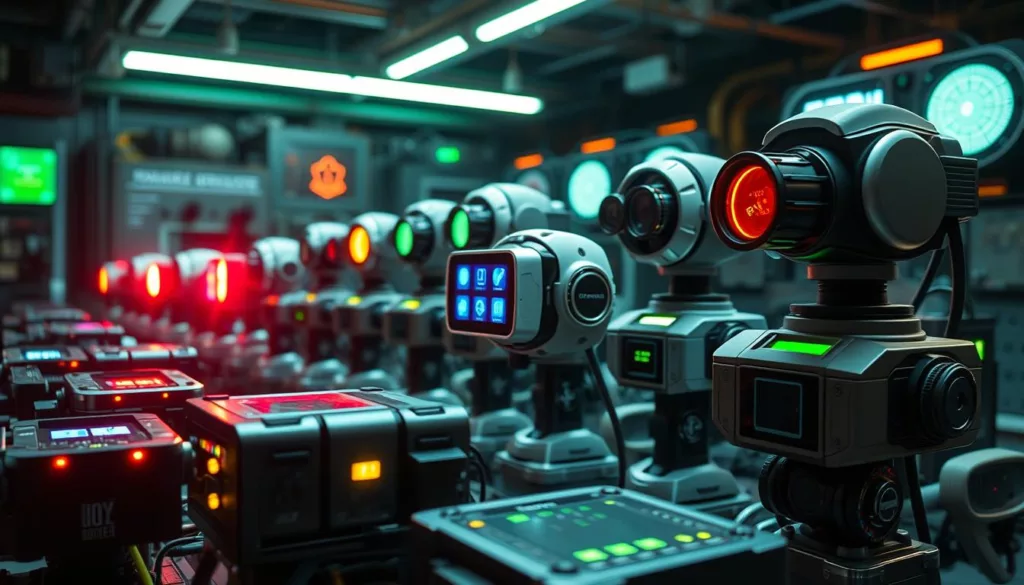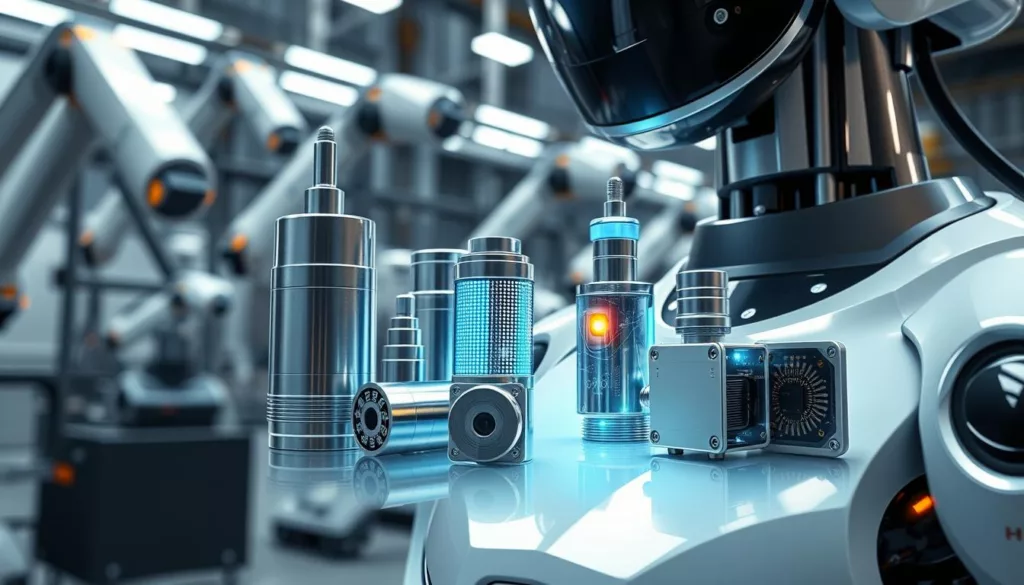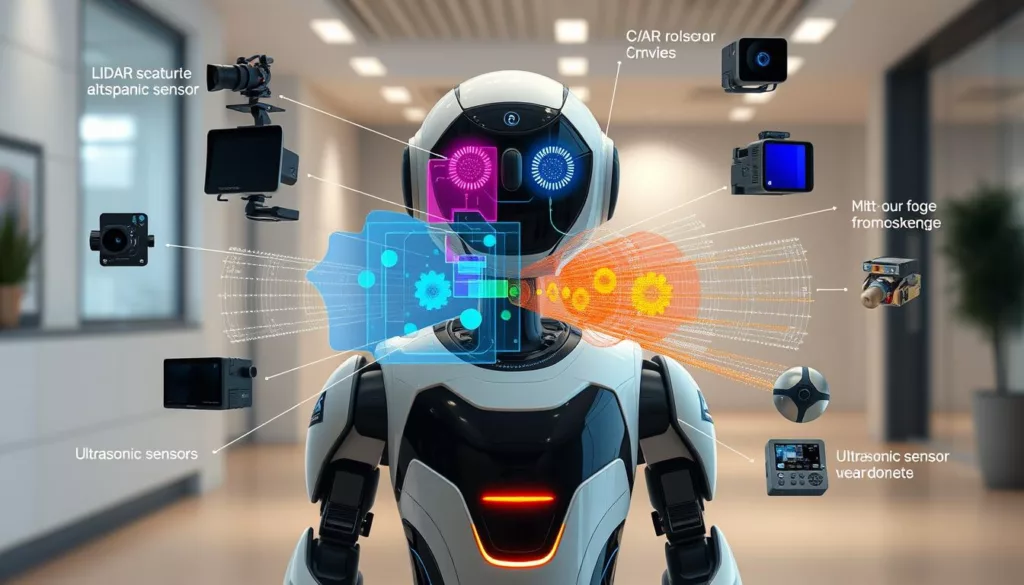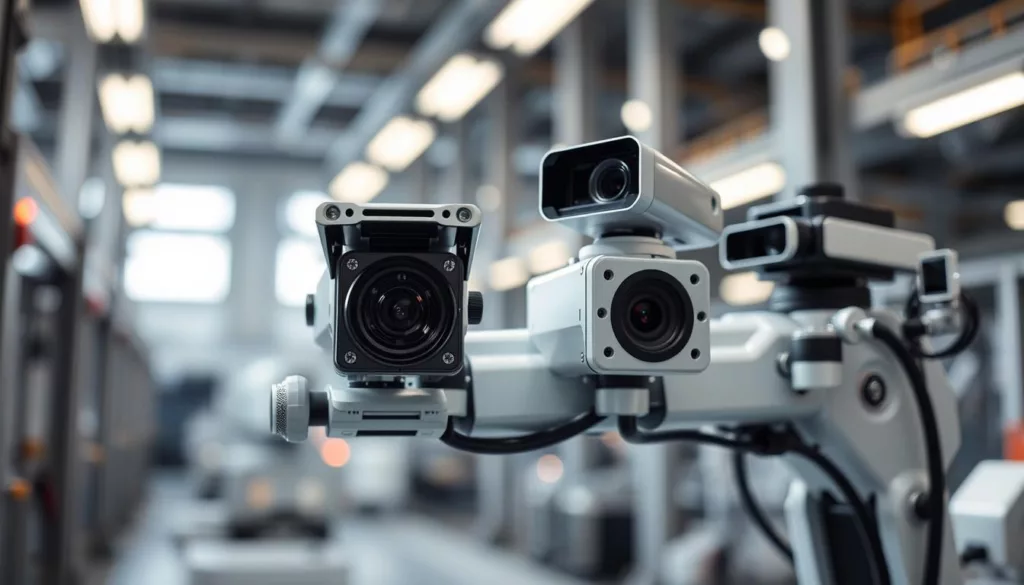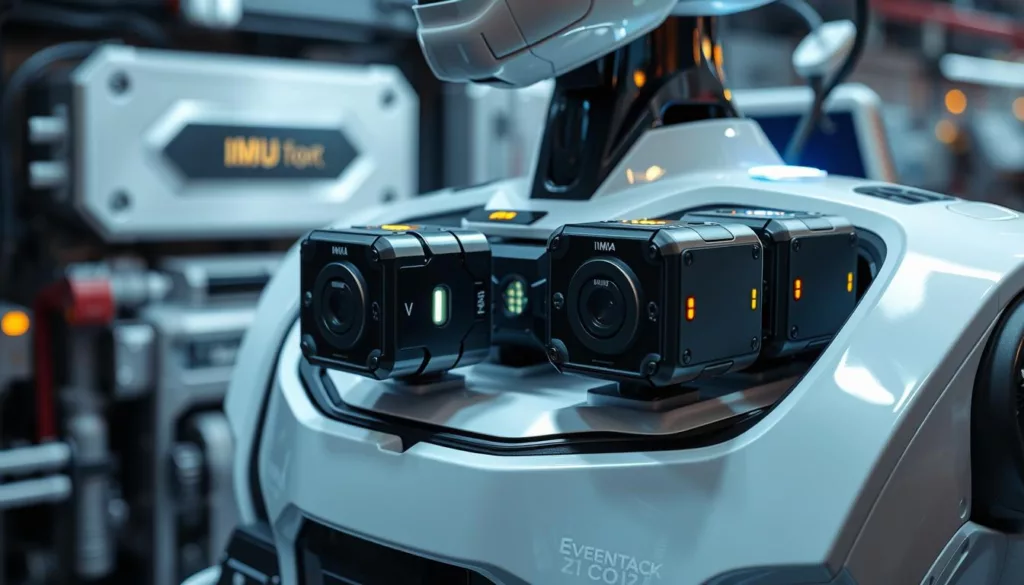In today’s fast-changing world, high-precision sensors in service robots are key. These sensors help robots move, see, and interact with their world with great accuracy. They are used in many areas, like warehouses and healthcare, making robots smarter and more efficient.
There are many types of sensors, each solving different problems for robots. Proximity sensors find obstacles, while camera systems give detailed views of the environment. Lidar and force-torque sensors help robots move over complex areas and handle objects carefully.
The need for precise sensors is growing as more industries want automation. With these advanced sensors, robots can work faster, more accurately, and reliably. This change is big, affecting many fields and shaping the future of work.
Key Takeaways
- High-precision sensors are vital for service robots’ success in automation.
- Different sensors, like proximity and lidar, help robots understand their world better.
- New sensor tech is changing many industries, from warehouses to healthcare.
- Combining sensor data makes robots more accurate and reliable.
- The future of work will be greatly influenced by advanced sensor technology in robots.
Introduction to Service Robot Sensors
The world of service robotics is changing fast. It’s transforming industries and how we use automation. At the center of this change are the advanced sensors that make these robots smart. They let the robots see and adapt to their surroundings like never before.
Overview of Service Robotics
Service robots are helpful machines that do many tasks. They work in healthcare, hospitality, logistics, and even agriculture. These robots use LiDAR technology and machine vision cameras to get better at their jobs. They offer efficient, reliable, and responsive service.
Importance of Automation
Automation is key in today’s businesses. It helps companies work better, be more productive, and give better service. Service robots with top-notch sensors are key to this change. They help companies work smarter, use less manual labor, and serve more consistently.
How Sensors Enhance Performance
- Precise object detection and tracking with LiDAR technology and machine vision cameras
- Enhanced situational awareness and obstacle avoidance
- Improved decision-making and task execution
- Increased efficiency and productivity
- Enhanced safety and reliability
Thanks to these advanced sensors, service robots are changing industries. They’re driving innovation and making a future where humans and robots work together smoothly.
Types of Service Robot Sensors
Service robots use many sensors to move around, find obstacles, and interact with things. From simple proximity sensors to advanced LiDAR technology, each sensor is key to their success. Let’s explore the main types of sensors that are changing service robotics.
Proximity Sensors
Proximity sensors help robots know when they’re near objects. They use infrared or ultrasonic tech to measure distance. This lets robots avoid hitting things and move safely.
These sensors are great for avoiding objects, controlling position, and measuring distance.
Camera-Based Sensors
Cameras are vital for service robots to see their world. They take clear images and videos. This lets robots recognize objects, see people, and understand complex scenes.
With computer vision and 3D reconstruction, robots can really get to know their surroundings. This helps them make smart choices and act on them.
LiDAR Sensors
LiDAR sensors are a big deal in service robotics. They use laser pulses to make detailed 3D maps of the environment. This gives robots a clear picture of their surroundings.
LiDAR sensors are perfect for finding objects, mapping terrain, and navigating on their own. This makes robots move safely and efficiently.
Force-Torque Sensors
Force-torque sensors are important for robots that need to handle things carefully. They measure the forces and torques on a robot’s end-effector. This lets robots know how much force to use for tasks like picking up objects or working with humans.
With these sensors, robots can do delicate tasks safely and with precision.
Service robots also use odometry systems and IMU sensors to track their movement and direction. These systems help robots know exactly where they are and how to get where they need to go.
| Sensor Type | Key Applications | Advantages |
|---|---|---|
| Proximity Sensors | Object avoidance, position control, distance measurement | Reliable, cost-effective, simple integration |
| Camera-Based Sensors | Object recognition, scene interpretation, 3D reconstruction | High-resolution perception, advanced computer vision capabilities |
| LiDAR Sensors | Terrain mapping, object detection, autonomous navigation | Precise 3D mapping, reliable obstacle detection, long-range sensing |
| Force-Torque Sensors | Object manipulation, assembly, physical interaction | Accurate force and torque measurement, enhanced control and safety |
By using these different sensors, service robots can move around with great precision. They can detect and interact with objects and people. And they can do many tasks more efficiently and safely.
Applications of High-Precision Sensors in Robotics
Robotics is changing many industries, and high-precision sensors play a big role. They help robots work accurately and efficiently in places like warehouses, healthcare, and farms. Let’s look at how force/torque sensors and 3D imaging sensors are making a big difference.
Warehouse Automation
Robots with force/torque sensors are changing warehouses. They can handle fragile items carefully. 3D imaging sensors help them move around safely and avoid hitting things. This makes orders faster, saves money, and keeps inventory in order.
Healthcare Robotics
In healthcare, robots are helping with surgery, rehab, and caring for patients. Force/torque sensors let surgical robots do complex tasks with great skill. 3D imaging sensors help rehab robots tailor therapy plans. This helps patients get better faster and eases the work of doctors and nurses.
Agricultural Robotics
Robots with force/torque and 3D imaging sensors are changing farming. They help tractors and harvesters move around fields well. Robotic arms can pick and sort fruits and veggies carefully, reducing waste and increasing crop yield.
Hospitality and Service Industries
The hospitality and service sectors are also seeing benefits from these sensors. Robotic concierges and hotel staff use 3D imaging to move around and talk to guests. Force/torque sensors let robotic bartenders and waiters handle glassware and pour drinks with care.
As more people want automation and precision, the use of force/torque and 3D imaging sensors in robotics will keep growing. This will change many industries and make our lives better.
Benefits of High-Precision Sensors
High-precision service robot sensors bring many benefits to automation. They improve performance and efficiency. These sensors are key to unlocking robotics’ full power in many industries.
Increased Accuracy and Efficiency
Proximity sensors and other high-precision sensors offer unmatched accuracy. This means robots can do tasks with great precision. This precision leads to better efficiency, as robots work more reliably and waste less.
Improved Safety and Reliability
Safety in human-robot interaction is very important. Proximity sensors help robots detect humans and obstacles. This prevents accidents and keeps the work area safe. Also, these sensors make robots reliable, cutting down on downtime and improving overall system reliability.
Enhanced Decision-Making Capabilities
Advanced sensors, like camera-based and lidar systems, give robots the ability to gather detailed data. This data, combined with analytics and machine learning, helps robots make smarter decisions. This leads to better problem-solving and improved results.
| Benefit | Description |
|---|---|
| Increased Accuracy and Efficiency | High-precision sensors ensure robotic systems can perform tasks with exceptional precision and reduced errors, leading to improved efficiency. |
| Improved Safety and Reliability | Proximity sensors enable safe human-robot interaction, while sensor reliability enhances overall system performance and uptime. |
| Enhanced Decision-Making Capabilities | Advanced sensors, such as camera-based and lidar systems, provide robots with valuable data to make more informed, intelligent decisions. |
Using high-precision service robot sensors can greatly improve efficiency, safety, and intelligence in automation. This leads to better productivity and a competitive edge for businesses.
Challenges in Implementing Service Robot Sensors
Adding precise sensors to service robots is tricky. It involves many factors, from the environment to tech limits. Makers of these robots must tackle these issues to get the best sensor performance and smooth integration.
Environmental Factors
Service robots work in changing, unpredictable places. They face many environmental challenges. Things like temperature changes, humidity, dust, and interference can mess up sensor data. It’s key to create sensors that can handle these issues well.
Technological Limitations
Even with fast tech progress, sensors have their limits. For instance, LiDAR technology can be affected by sunlight. Sensor fusion helps solve these problems. But finding the right balance between cost, performance, and energy use is hard.
Integration with Existing Systems
Making new sensors work with a robot’s old parts is tough. It needs careful work on communication, data, and control systems. Also, updating old systems with new sensors is costly and time-consuming.
Beating these hurdles is key for service robots to be used more in healthcare, logistics, and farming. By tackling environmental issues, using new tech, and improving system integration, robot makers can unlock sensors’ full power. This will shape the future of automation.
Key Features to Consider in Sensors
When picking sensors for service robots, it’s key to look at several important features. These features affect how well the system works. From how fast it responds to what it can detect, each detail is vital.
Responsiveness and Speed
The sensor’s quickness and accuracy are top priorities. Machine vision cameras and odometry systems need to act fast. This ensures the robot moves smoothly and handles changing situations well.
Any delay can hurt the robot’s performance. So, choose sensors that are both quick and precise.
Range and Detection Capabilities
The sensor’s range and what it can detect are also key. The tasks your robot will do affect what sensors you need. You might need sensors that can see far, detect in many ways, or work in different conditions.
Make sure the sensors can meet your needs. They should cover the area you need and give the right awareness.
Cost and Maintenance Factors
Think about the long-term costs and upkeep of the sensors. While better sensors might cost more, they could save money in the long run. They might last longer, work better, and be easier to maintain.
Look at the total cost, including setup, calibration, and ongoing care. This helps you pick sensors that fit your budget and needs.
By looking at these features, you can pick the right sensors for your service robot. They should be fast, detect well, and be cost-effective. This will help your automation projects succeed.
Innovations in Sensor Technology
The world of service robotics is changing fast, thanks to new sensor tech. AI and machine learning are key, along with advances in materials. These changes will make service robots smarter and more able to work with their surroundings.
AI and Machine Learning in Sensor Deployment
AI and machine learning are changing how service robots use sensors. Robots can now make better choices and work more efficiently. This is because they use advanced analytics and sensor data.
Advancements in Material Science
New materials are also leading to better sensors. Scientists are finding materials that are stronger, more sensitive, and cheaper. This means sensors can work better in tough places and be more accurate.
Future Trends in Sensor Integration
Service robotics will keep getting better, with sensors playing a big role. We’ll see sensors that can do many things at once. And sensor networks will let robots share data and work together.
Thanks to these advances, service robots will be able to do more. They’ll be able to move around easily, work with people, and do tasks with great skill and speed.
Leading Brands in Robotics Sensor Solutions
In the fast-changing world of service robotics, a few top sensor makers lead the way. Siemens, Cognex, Omron, and Bosch are at the forefront. They’re pushing the limits with their 3D imaging and proximity sensors.
Siemens: Precision Meets Versatility
Siemens is a giant in sensor tech. Their 3D imaging sensors are super accurate, helping robots move through tough spots. Their proximity sensors are quick and reliable, making sure robots and machines work well together.
Cognex: Machine Vision Mastery
Cognex is a top name in machine vision. Their 3D imaging sensors use smart algorithms and learning to help robots make smart choices. Their proximity sensors add to the safety and dependability of automated systems.
Omron: Innovative Automation Solutions
Omron is a big name in Japan for service robot sensors. Their 3D imaging sensors offer amazing depth and object recognition. This is key for tasks like warehouse work and healthcare. Their proximity sensors make sure robots and their world interact smoothly.
Bosch: Driving the Future of Robotics
Bosch is a big name in Germany for service robotics sensors. Their 3D imaging sensors are known for being accurate and reliable. Bosch’s proximity sensors also make automated systems safer and more efficient.
These leaders are changing what service robots can do. They’re making automation a part of our everyday lives.
| Brand | Specialty | Key Innovations |
|---|---|---|
| Siemens | 3D Imaging Sensors, Proximity Sensors | Unparalleled accuracy, Responsive detection capabilities |
| Cognex | 3D Imaging Sensors | Complex algorithms, Deep learning integration |
| Omron | 3D Imaging Sensors, Proximity Sensors | Cutting-edge depth perception, Seamless interaction |
| Bosch | 3D Imaging Sensors, Proximity Sensors | Accuracy, Reliability, Safety and efficiency |
“These industry leaders are redefining the capabilities of service robots, paving the way for a future where automation is seamlessly integrated into our daily lives.”
Regulatory Standards for Service Robot Sensors
High-precision service robot sensors are becoming more common. It’s important to know the rules that govern their use. These rules cover safety, environmental impact, and data privacy. They help make sure these sensors are used responsibly and effectively.
Safety Certifications
Service robot sensors in places like hospitals or factories need to be very safe. They must pass tests to show they are reliable and accurate. Organizations like ISO and OSHA check these sensors to make sure they are safe for users.
Environmental Regulations
The way sensor technologies affect the environment is a big concern. Rules are being made to make sure these sensors are green and don’t harm the planet. Companies must follow rules from places like the European Union to use materials and energy wisely.
Data Privacy Considerations
More robots with sensors mean more data collection. Laws like GDPR in Europe and CCPA in the US set rules for this data. These laws help keep people’s information safe when they use robots.
These rules are very important for the future of service robots. Companies need to keep up with these standards. They must make sure their sensors are safe, green, and protect people’s data.
| Regulatory Standard | Scope | Key Requirements |
|---|---|---|
| ISO 13849-1 | Safety of machinery | Establishes safety-related performance levels for control systems, including sensor components. |
| OSHA standards | Occupational safety and health | Outlines safety requirements for industrial and workplace equipment, including sensors and automation. |
| RoHS directive | Restriction of hazardous substances | Limits the use of certain hazardous materials in the manufacture of electronic and electrical equipment. |
| GDPR | Data protection and privacy | Regulates the collection, storage, and processing of personal data, including sensor-generated information. |
Case Studies of Successful Automation
Many industry leaders have made big strides in high-precision sensors and automation. Let’s look at three examples that show how these technologies have changed the game.
Amazon Robotics
Amazon, a huge name in e-commerce, has led the way in using LiDAR and machine vision cameras. They’ve introduced advanced robots to their warehouses. These robots can find and move items with great accuracy, making things faster and cheaper.
Boston Dynamics
Boston Dynamics is famous for its smart and flexible robots. Their robots use LiDAR and machine vision cameras to move and handle things in tricky spots. They can go over rough ground and even pick up small items, showing what sensors can do.
Toyota Research Institute
The Toyota Research Institute is working hard to make cars drive themselves. They’ve added LiDAR and machine vision cameras to their cars. This helps them see and avoid things better, making driving safer.
These stories show how LiDAR and machine vision cameras have changed things. They’ve helped big companies do amazing things in automation. As we need more smart and efficient systems, these examples are a great guide for the future.
Future Prospects of High-Precision Sensor Technology
The future of high-precision sensor technology in service robotics is bright. New markets in fast-growing areas offer big chances for advanced automation. Better odometry systems and IMU sensors will make service robots more reliable and efficient.
Emerging Markets and Opportunities
Places like Asia, Africa, and Latin America are ready to use service robots. They need better healthcare, farming, and logistics. High-precision sensors will help robots work well in these places.
Predictions for Automation Growth
Experts say service robots will be used more in many fields soon. The service robotics market will grow fast. Better sensors will make robots more common in our lives, changing how we use technology.
The Role of Robotics in Sustainable Development
High-precision sensors in service robots can help the environment too. They can use resources better, cut down on waste, and monitor the environment. Robotics will play a big part in solving global problems in the future.

